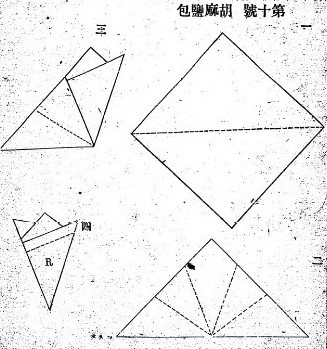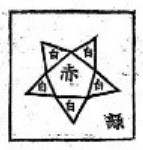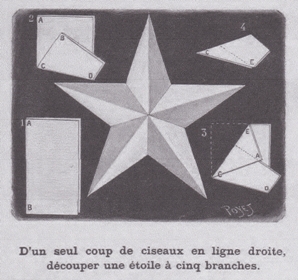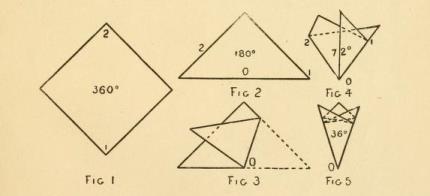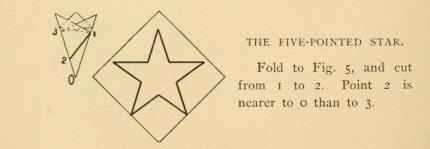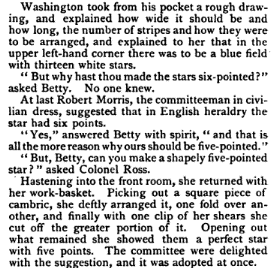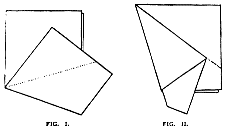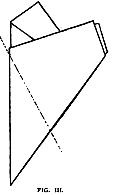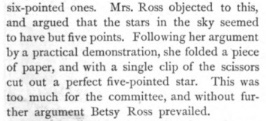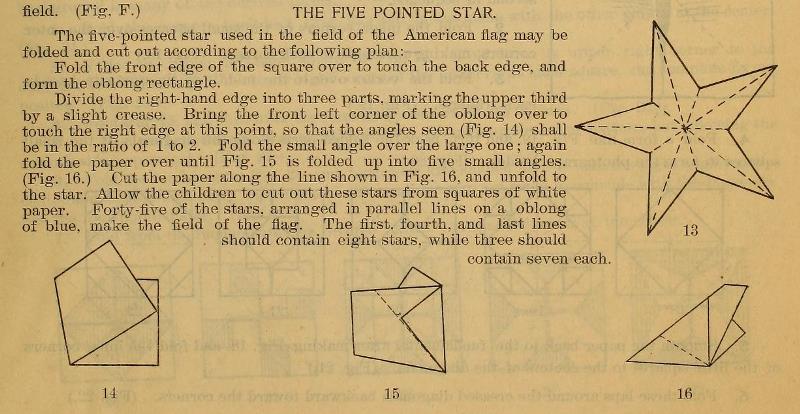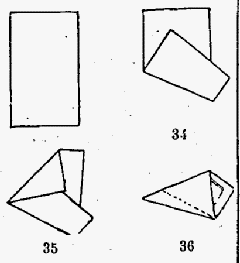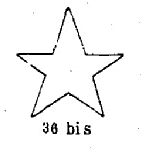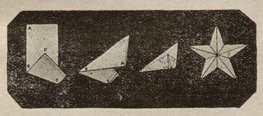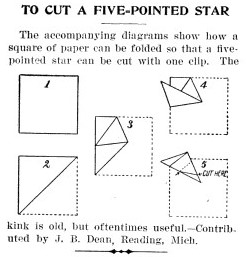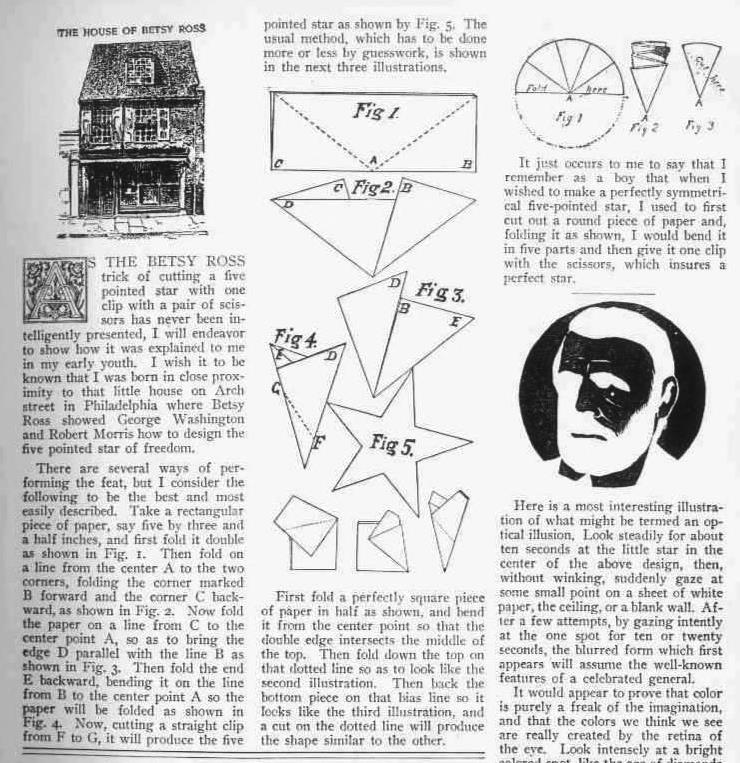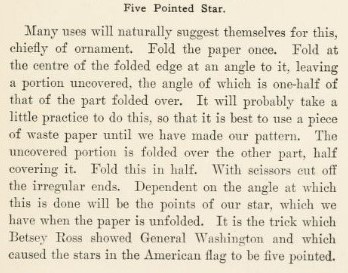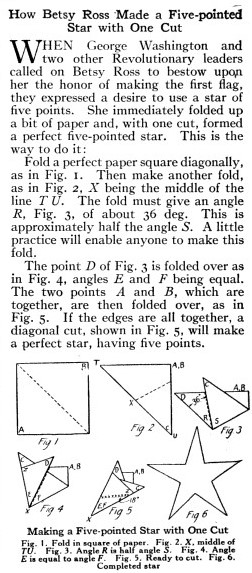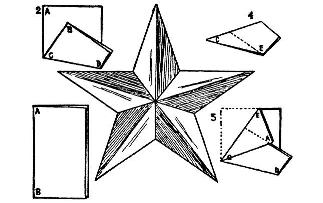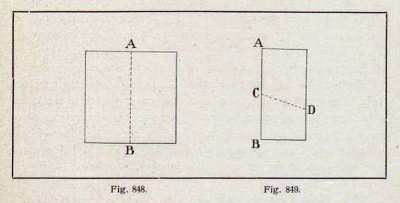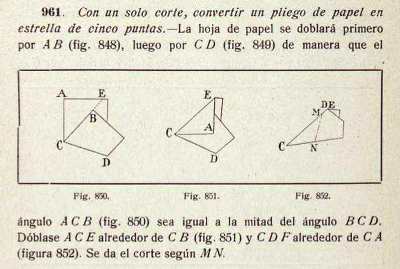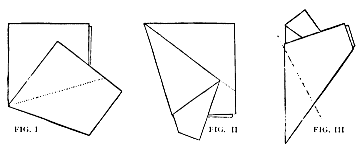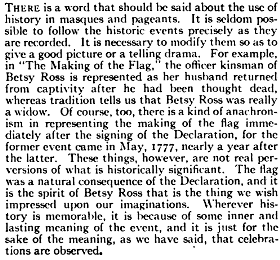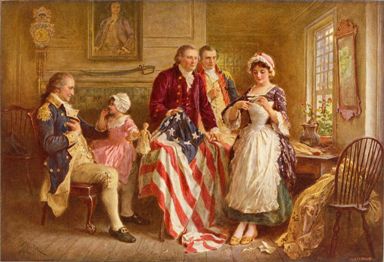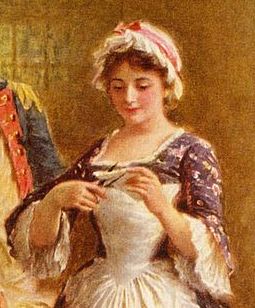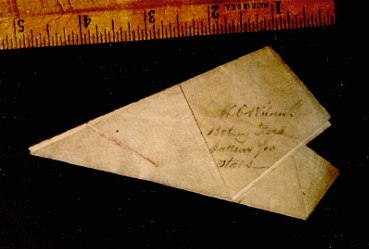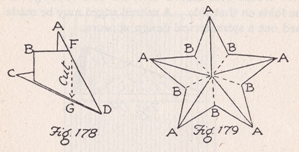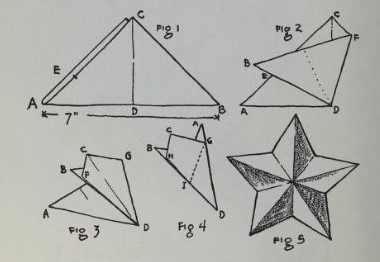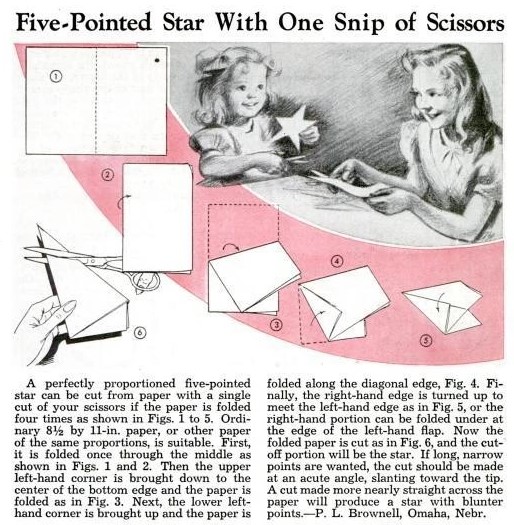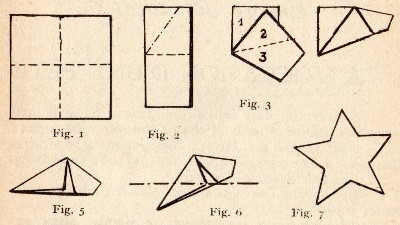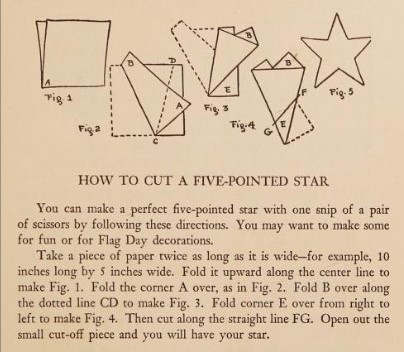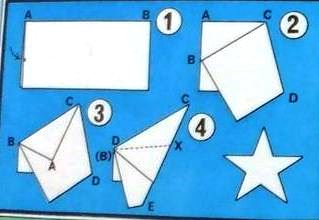| The Public Paperfolding History Project
Last updated 8/5/2025 x |
|||||||
| The Fold and One Cut Pentagram / Five-Pointed Star / Betsy Ross Star | |||||||
| This
page is being used to collect information about the
history of the paperfolding design known variously as the
Fold and One Cut Pentagram or Five-Pointed Star or the
Betsy Ross Star. Please contact me if you know any of
this information is incorrect or if you have any other
information that should be added. Thank you. ********** In Japan (and in books by Japanese authors) 1904 A version of the Fold and One Cut Pentagram appears in 'Shukouka Kyoju Shishin: Maiji Haitou' by Hyojiro Nakagaki, which was published by Kenseikai in Tokyo in 1904.
********** 1951 Brief instructions foir making this design can also be found in 'Origami to Kirinuki' by Saburo Ueda, which was published by Kokkado in Tokyo, most probably in 1951.
********** In Europe, the Americas and Australasia 1870/3 As far as I know the first mention of this design is in a paper read by William J. Canby to the Historical Society of Pennsylvania in March 1870 entitled 'The History of the Flag of the United States'. In this paper William Canby includes a story told to him by Mrs Clarissa S Wilson the daughter of Elizabeth Claypoole, also known as Betsy Ross, which tells how she was visited one day by George Washington who showed her a drawing of a proposal for a new version of the United States flag which included a number of six-pointed stars. William Canby states, 'Mrs Ross at once said that this was wrong; the stars should be five pointed; they were aware of that, but thought there would be some difficulty in making a five pointed star. "Nothing easier" was her prompt reply and folding a piece of paper in the proper manner, with one clip of her ready scissors she quickly displayed to their astonished vision the five pointed star; which accordingly took its place in the national standard.' The year this alleged visit took place is not given in the document but is generally given in other sources as 1776. The full text of this document can be found here. The story is now generally believed to be apocryphal since there is no corroborating evidence from contemporary sources. However, the existence of the Fold and Cut Pentagram design in 1870 is clearly established by this source. Rachel Fletcher, another daughter of Betsy Ross, signed an affidavit on July 31st 1871 corroborating many of the details of William Canby's version of events. This affidavit does not, however, mention Betsy Ross cutting a five-pointed star from paper. The whole story, including mention of the Fold and One Cut Pentagram, was subsequently published as historical fact in an article entitled 'National Standards and Emblems' in Harper's New Monthly Magazine in 1873 and, according to https://www.history.com/news/did-betsy-ross-really-make-the-first-american-flag 'soon became part of the United States history curriculum taught to millions of elementary-aged school children every year.' ********** 1891 The Fold and One Cut Pentagram, made from a square, was published in 'L'Illustration' 2541 of 7th November 1891 and subsequently included in Volume 3 of 'La Science Amusante' by Tom Tit (real name Arthur Good) which was published in Paris by Librairie Larousse in 1893.
********** 1892 Fold and one cut methods for creating many polygonal shapes from squares and circles, including the pentagram, appeared in 'Paper Folding and Cutting' by Katherine M Ball, which was published by the Prang Educational Company in Boston in 1892. This book does not reference any previous sources for these designs.
********** The July 1892 issue of the American children's magazine St Nicholas contained an article titled 'The Five-Pointed Star' by Charles F Jenkins which gave a version of the Betsy Ross story.
********** 1893 A much longer article on a similar theme, entitled 'The Stars and Stripes', and written by Henry Russell Wray appeared in the issue of St Nicholas magazine for September 1893. This article did not include diagrams but included the passage:
********** 1894 The Betsy Roass story and diagrams for making the star also appear' in 'Old Glory: The Flag of Our Country: A Study in History and a Lesson in Paperfolding: Also Some Easy Lessons in Cutting and Folding' by Dr Albert Elias Maltby, which was published in Slippery Rock, Pennsylvania in 1894.
********** The design also appears: 1899 In 'Le Livre des Amusettes' by Toto, published in Paris by Charles Mendel in 1899.
********** 1904 As 'Poligonos Estrellados' in 'Guia Practica del Trabajo Manual Educativo' by Ezequiel Solana, which was published by Editorial Magisterio Español in Madrid in 1904.
********** 1905 As 'To Cut a Five-Pointed Star' in Popular Mechanics Magazine for December 1905. Information from José Tomas Buitrago.
********** 1914 Sam Loyd's 'Cyclopedia of Puzzles', which was published by The Lamb Publishing Company in New York in 1914 gives three methods of creating a fold and cut pentagram.
********** 1915 As 'Five Pointed Star' in 'Occupational Therapy: A Manual for Nurses' by William Rush Dunton, which was published by the W B Saunders Company in Philadelphia and London in 1915. These instructions also mention the Betsy Ross legend.
********** 1916 In Popular Science Magazine for April 1916. Information from José Tomas Buitrago.
********** 1918 As 'The Five-Pointed Star with a Single Cut' in 'Scientific Amusements' (an English translation of some of the material from volumes 2 and 3 of 'La Science Amusante' by Tom Tit) which was published by Thomas Nelson and Sons Ltd in London in 1918.
********** In ''Ciencia Recreativa' by Jose Estralella, which was published by Gustavo Gili in Barcelona in 1918.
********** 1921 The June 1921 issue of St Nicholas contained a third article about Betsy Ross, titled 'The Making of the Flag' and written by H B Alexander, which contained a patriotic masque or play, part of which read:
This article contained the same diagrams as had previously appeared in the July 1892 edition:
And the following comment on the treatment of history in patriotic masques which is surely pertinent to the legend of Betsy Ross as a whole:
********** Undated A picture of Betsy Ross cutting out a five-pointed star for George Washington (seated left) and others was painted by Jean Leon Gerome Ferris (1863 – 1930) as part of his patriotic 'Pageant of a Nation' series. I do not know the date this particular picture was painted. It is, however, clear from the detail that the artist did not know how this feat could be achieved with just a single cut.
********** 1922? According to an article 'Betsy Ross Revisited: General Fold and One-Cut Regular and Star Polygons' by Arnold Tubis and Crystal Elaine Mills in Origami 5: The Fifth International Meerting of Origami, Science, Mathematics and Education, a partially cut pentagram folded from a piece of 8" x 5" paper was shown in 1963 to the Women's Committee of the Philadelphia Flag Day association by Reeves Wetherill. He claimed that this artifact had been found by his father in 1922 when an old safe belonging to a previous member of the family had been opened. The writing on this artifact says, 'H C Wilson Betsey Ross Pattern for Stars', H C Wilson possibly referring to Betsy Ross's daughter Clarissa Claypoole Wilson. So far as I know no effort to date this artifact scientifically has been made.
********** Diagrams for this design also appear: 1922 In 'Houdini's Paper Magic', published by E P Dutton and Company of New York in 1922.
********** 1928 In 'Fun with Paperfolding' by Rigney and Murray, published by the Fleming H Revell Company, New York in 1928.
********** 1938 In an article in the Australian newspaper The Age for 20th December 1938.
********** 1939 In 'Fun with Paper' by Joseph Leeming, which was published by Spencer Press Inc in Chicago in 1939.
********** 1945 In Popular Mechanics Magazine for July 1945. Information from José Tomas Buitrago.
********** 1949 As 'Etoile a Cinq Branches' in 'Au Pays des Mains Agiles', which was published by Editions Fleurus in Paris in 1949.
********** 1950 TIn 'Holiday Craft and Fun' by Joseph Leeming, which was published by J B Lipincott Company in Philadelphia and New York in 1950.
********** 1963 As 'The Five-Pointed Star' in 'Fell's Guide to Papercraft: Tricks, Games and Puzzles' by Walter B Gibson, which was published by Frederick Fell Inc in New York and George McLeod Ltd in Toronto in 1963.
********** 1964 The 1964 Rupert Annual contained instructions for folding 'Rupert's Paper Star'.
********** |
|||||||
